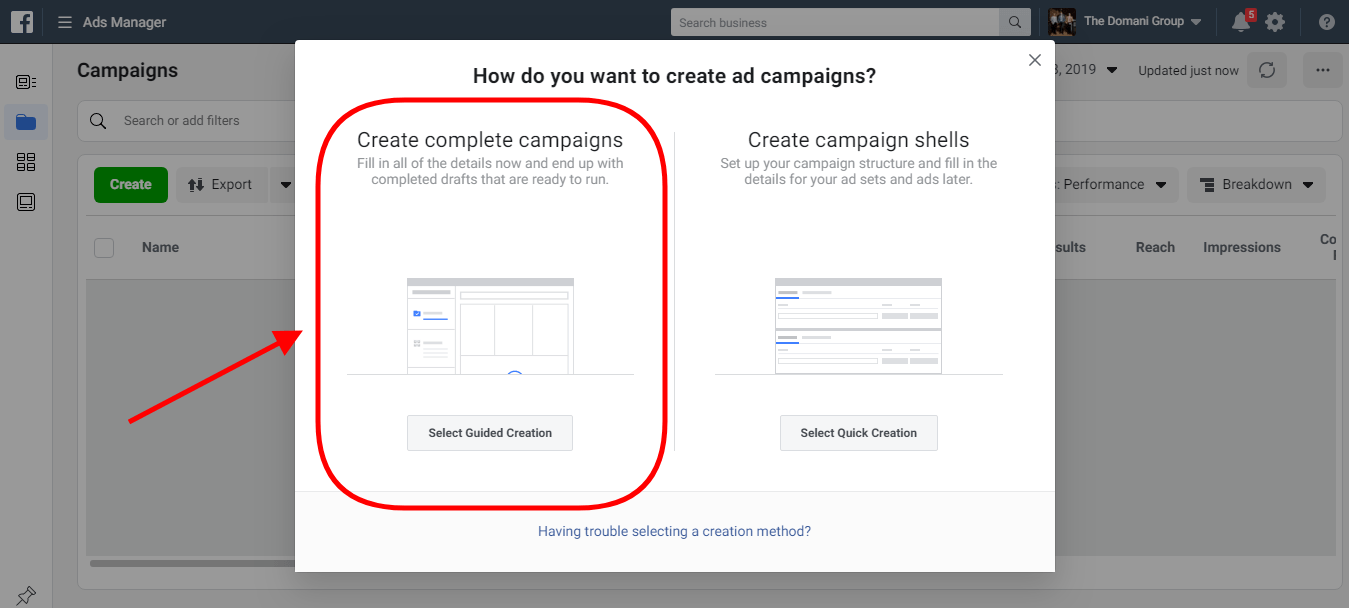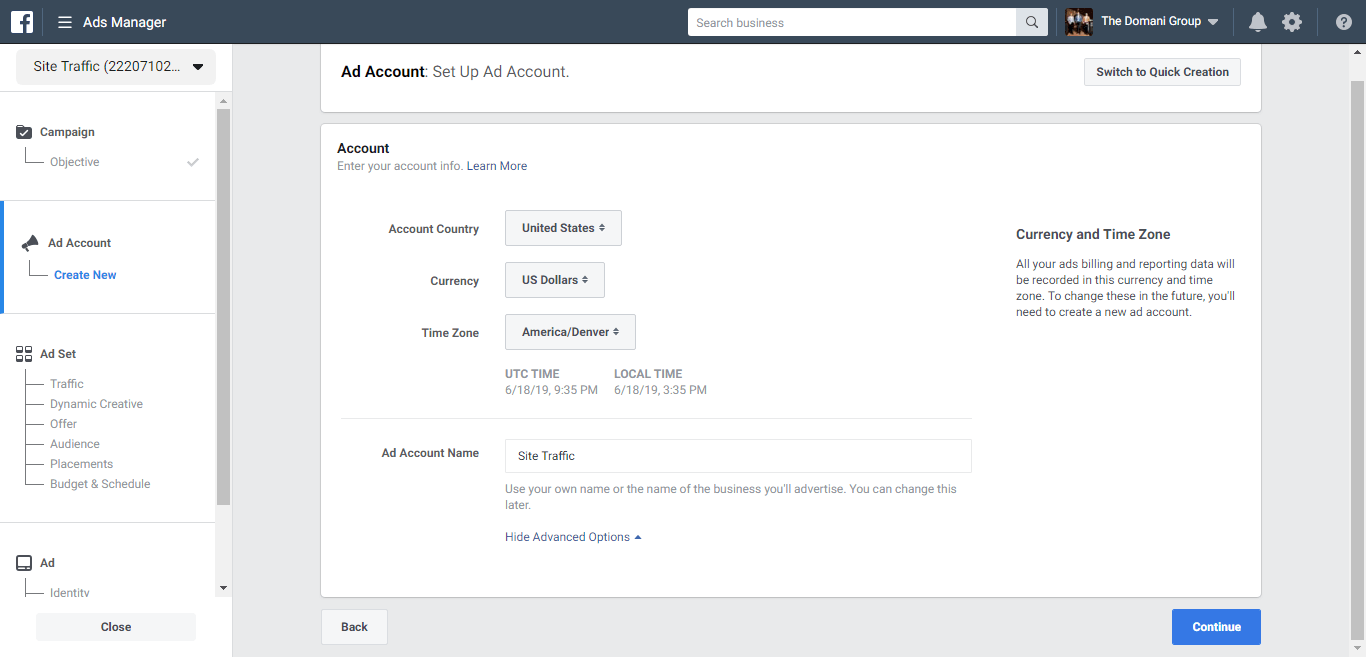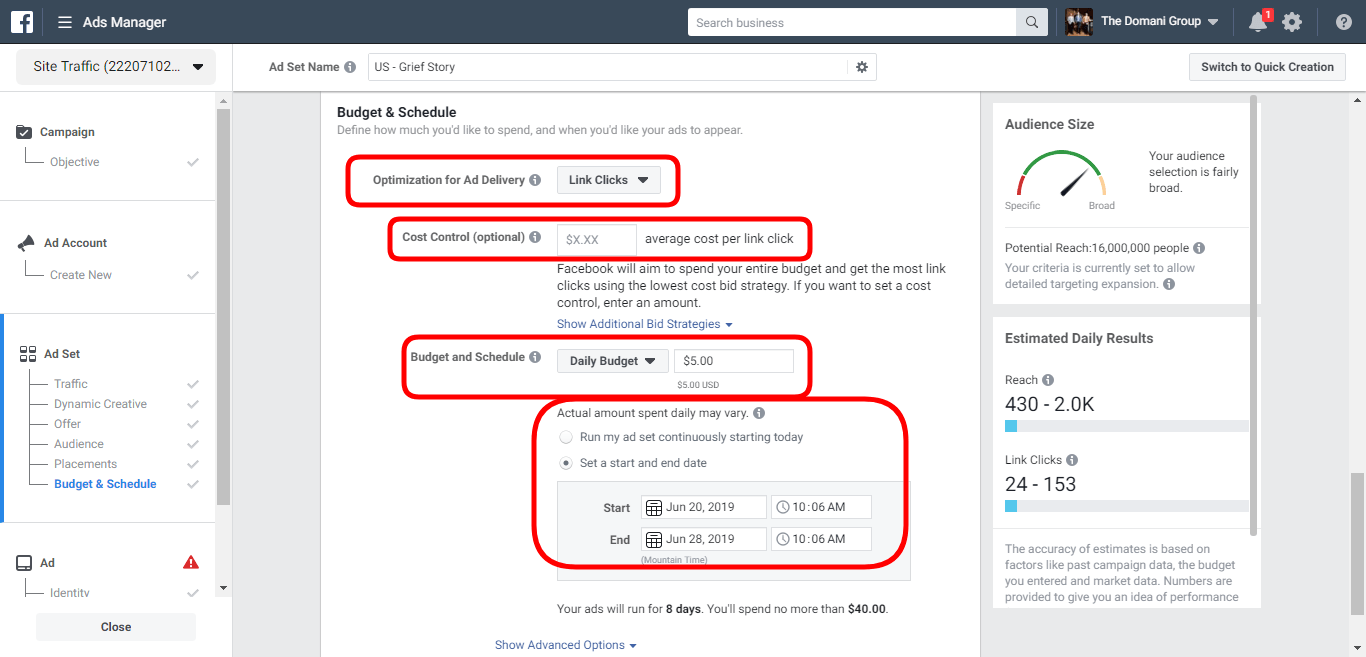Complete Guide to Funeral Home Facebook Advertising
Chad Zollinger • June 20, 2019
Facebook advertising is one of the most effective advertising options for funeral homes for three reasons:
- It is the easiest option for targeting a local audience.
- Speed of digital ads means your message gets out fast and the results come in quickly.
- Funeral home target audience is more likely to be on Facebook than any other social media platform.
The problem is learning to create high-performing Facebook ads takes time. And time is a rare commodity for funeral home owners.
Alongside SEO for funeral homes, digital advertising is one of the most important marketing skills you can learn as a small business owner.
You just don’t have the time to read through 10 different guides on Facebook advertising for funeral homes.
We’ve created this complete step-by-step guide for funeral home Facebook ads.
If you know your audience (most funeral home owners know their audience extremely well), you have everything you need to create a high-performance Facebook Ad for your funeral home.
How to Create a Successful Facebook Ad Campaign for Your Funeral Home
Follow the steps below to create your first Facebook ad campaign targeted directly to your funeral home’s audience:
- Create Campaign and Select Your Objective
- Set Up Your Campaign and Account
- Creating Your Ad Set and Target Audience
- Choose Ad Placement
- Set Your Budget, Schedule
- Create the Ad
Step 1 - Create Campaign and Select Your Objective
First things first, you need to login to Facebook Ads Manager by clicking “Manage Ads” from the top-right dropdown menu on Facebook.
Then click the dropdown menu near the top-left of the page and select “Ads Manager.”
Next, you’ll click “create” to get started with your first campaign.
You’ll want to select the first creation option “Create complete campaigns,” which is better for first-time Facebook advertisers.
The first thing Facebook wants to know when you begin your ad creation is the objective of the ad itself. If you’re looking to sell a product on Facebook, you’ll be targeting a specific audience.
Facebook tracks user behaviors and knows which users are more likely to convert into leads and which are more likely to follow a Facebook page. So if your objective is simply to get more Facebook page followers or increase your brand awareness, you should select “Brand Awareness.”
As funeral home owners, your target audience is researching and preparing for funerals. These are people who are ready to accept your services.
There are 11 total objective types you can choose from. But, there are specific objective types that will fit your funeral home best. Here are the objectives you should consider to reach your target audience:
- Traffic: If you just want to send people to your site.
- Messages: If you want to talk directly to your audience. This option works well when you are targeting funeral preneed customers.
- Video views: If you want to showcase a unique service with a video to drive leads.
- Lead generation: If you want to collect contact information quickly and easily.
- Brand awareness: If you want to increase the visibility of your funeral home in your local market.
Step 2 - Set Up Your Campaign and Account
Choose a name for your campaign and enter it into the text box. You will also have two campaign options here. You can either turn on Create Split Test or Campaign Budget Optimization.
Campaign Budget Optimization: This option allows you to optimize your budget spend on the best ads depending on your specified preferences.
You can experiment with these options later on. For now, let’s leave both options off and continue with our basic ad.
The next screen you’ll see is the account setup screen.
Simply select your desired country, currency, time zone, and ad account name. These settings are final. If you’d like to change any of these settings, later on, you’ll have to create a new ad account.
Step 3 - Creating Your Ad Set and Target Audience
There are a number of different options in this section. You’ll want to individualize this to your own ad.
Ad Set Name: An ad set on Facebook will be viewable in reporting during and after the ad is published. An ad set is a group of ads that have the same schedule, budget, delivery settings, and targeting.
You’ll want the name to revolve around the type of ads you are planning on creating. If you are pushing an article, name the ad set “US - Article Ads” to differentiate between lead ads or video ads.
Traffic: Select where you’d like to drive traffic. In our case, we’d like the traffic to end up reading an article on our site. So we chose “website.”
You can also choose an app, messenger, or WhatsApp.
Dynamic Creative: You can upload multiple videos, images, and captions. This means Facebook will automatically combine captions with different videos and images to find the combination that converts the most traffic or gets the best engagement.
Offer: If you can provide a discount for those who convert using this ad, you should do that here.
Audience: You can create a new audience or use a saved audience in this new campaign. You can add a saved audience to the new audience you are creating.
Customizable audience parameters include age, gender, language, detailed targeting, and connections. With detailed targeting, include all behaviors, interests, and demographics that may pertain to your target audience.
I also recommend checking the box that says “expand detailed targeting criteria when it may improve performance at a lower cost per result.”
Connections will narrow your audience further. For example, if you select a connection of people who like your page, then your target audience
will pool from those who like your page already.
Step 4 - Choose Ad Placement
You can choose to customize where you place your ads and on which devices they are seen. I recommend using automatic placements for the first time.
If you do opt to customize ad placement yourself, you may choose to target the following platforms and assets:
- Facebook: Feeds, Instant Articles, In-Stream Videos, Right Column Ads, Suggested Videos, Marketplace, Stories
- Instagram: Feeds, Stories
- Audience Network: Native, Banner, Interstitial, In-Stream Videos, Rewarded Videos
- Messenger: Inbox, Stories, Sponsored Messages
Automatic placements will appear on Facebook, Facebook Messenger, Audience Network (HuffPost, Vice, Time Inc., etc.), and Instagram.
Step 5 - Budget and Schedule
Budgeting will depend entirely on how much you’re willing to spend for the desired outcome.
Optimization for Ad Delivery: This is your desired outcome for the ad. You can choose one of the following outcomes:
- Landing page views
- Link clicks
- Impressions
- Daily unique reach
Cost Control: You can set the desired Cost per Click. This means that you can control the maximum cost for each click to your site. Cost control is optional and I recommend you do not use it if you are not confident in your average CPC estimation.
Budget and Schedule: You can either set a daily budget (ex: $5 per day for 10 days) or you set a lifetime budget (ex: $50 total on this ad).
You may also limit the ad duration by selecting a start and end date or you can run the ad continuously.
You should also know that Facebook ads work much better when they last longer.
Facebook’s algorithm goes through a learning period that can last several weeks. After this learning period, your Facebook ad will likely perform better.
Step 6 - Create the Ad
The ad you use should depend on the desired outcome. Some ads are more useful for growing your fan base
while others are more suited to attracting engagement.
For example, if you want subscribers to your blog, you should set aside a budget for a Lead Ad.
Here are all of the different kinds of ads for Facebook available to you:
Carousel Ads - Highlighting several different points of one service OR several different services/products. You can use up to 10 different photos or videos on the carousel ad.
Collection Ads
- An ad created exclusively for use on mobile phones. Users who see a collection ad may simply click a product they want to buy.
Dynamic Ads
- Dynamic ads are those targeted at users who may have a visited your page or a similar page. These ads are meant to follow up on those who already have an interested. If you are targeting an audience that may already be interested in your service, dynamic ads are your best bet (this is the best option for funeral homes marketing to potential families).
Instant Experience Ads
- These ads are full-screen ads that appear once a user interacts with your ad. Instant Experience Ads give you the ability to showcase your entire service instantly.
Lead Ads
- These ads allow you to gather names, phone numbers, emails, and other information from Facebook users. Leads ads should be shorter, easier to interact with, and are generally used to gather sign-ups and subscribers.
Messenger Ads
- You can also use Facebook Messenger to target your audience. Messenger ads include carousel ads, dynamic ads, photo ads, and video ads. Though some may consider messenger ads to be a bit more intrusive, they are useful to fulfill certain objectives. For example, a messenger ad may be more appropriate for opportunity ads or giveaways. If you are offering something free, a user may be more likely to trust you and respond.
Photo Ads
- Photos ads are by far the easiest option for funeral homes. However, they may not be the most effective for your target audience. Simply boost a post that you’ve already created to use a photo ad.
Slideshow Ads
- If you have a backlog of video and image content, then you could likely put together a pretty convincing slideshow. Showcase the many services and benefits of your funeral home with a slideshow ad.
Video Ads
- It’s already common knowledge that video ads perform better than static images on social media. What about your target audience? Do you think they would prefer to watch videos about your service than see a photo ad? Test video ads against photo ads to see which performs better.
You may also want to create a unique link for Google Analytics to track all of the clicks gained from this specific campaign.
Though you’ll be able to see the results of your campaign in the Facebook Ads Manager, creating a unique link will allow you to make further insights in Google Analytics, such as where the links end up on your site after the landing page.
You could also answer questions like:
- Do Facebook leads from this campaign convert into customers more than my last campaign?
- Do Facebook Ads convert better for me than LinkedIn, Google, or Twitter Ads?
Answering questions like these will help you identify which ads and platforms are best for attracting new customers.
Pro Tip: CPC Tracking
When judging whether an ad is successful or not, you’ll want to pay attention to the CPC, or Cost Per Click. Essentially, the CPC is the amount you are spending to on each individual click.
Good news: older audiences generally click more
on ads. This means that the average CPC for funeral homes will be lower.
If I spend $40 total on a Facebook ad and end up getting 40 clicks, my CPC is $1, which isn’t actually that bad compared to other industries.
However, for the funeral industry, you should aim for a CPC of $0.70. If you have an ad that has less than $0.70 CPC, then you’ve created a highly successful ad.
Ads should be up for at least 3 days. You need to let the ad work its way through Facebook’s algorithm. I would spend $5-$10 on the first 5 ads for a week. Then I’d spend $50+ on the highest performing ad.
Pro Tip: A/B Test Pivoting
A/B testing is the practice of comparing the results of two different variants in order to discover which performs best. For example, if I wanted to discover which soda people like better, I’d label one soda “A” and another “B” and give them to 1,000 people.
The test participants would pick their favorite one and we’d have our answer backed up by data.
In digital advertising, A/B testing is more rewarding and much more informative. And with the right tests, you can create the perfect Facebook ad for your funeral home.
If you learn to A/B test while pivoting to the highest performing ads (lowest CPC), you’ll easily grow your online presence. Here’s how to use A/B test pivoting to maximize the results of your funeral home facebook ads:
- Create 5 different ads.
- Target the same audience.
- Allocate a very small budget for each ad.
- Identify which ad performs best.
- Allocate a large budget to the highest performing ad.
- Repeat process after the highest performing ad campaign finishes; include your best performing ad from the previous 5 tests in the next 5 tests.
Funeral Home Articles

If there's one thing we've learned in 2020, it's that it's difficult to predict the future, and there will all be surprises that lie ahead. Businesses and individuals need to stay agile and adaptable to be ready for whatever life throws at them. 2020 has been a challenging year for the funeral profession and others as well. Still, we've seen that those funeral homes and funeral professionals who have focused on making their consumer experience as comforting and easy as possible are those that are winning. At Domani, we exist to help funeral homes help their families have a better experience. Through the power of text messaging, we follow up with families and give them the support and resources they need following a loss. That great experience then leads to a positive online review and helps others looking for a positive experience to find that funeral home. It's a virtuous cycle that helps grow a funeral home's at-need business. When it comes to preneed, the same principle holds. If funeral homes can provide the experience a family is looking for, that will be the funeral home that wins. During 2020, our preneed appointment setting team has found great success in scheduling remote appointments. Funeral homes that have been willing to adapt and find new ways to do business have grown even during difficult circumstances. We firmly believe that technology will help us as a funeral profession provide those better experiences for families, but simply using technology for technology's sake is not the answer. We need to leverage technology to help provide personal, engaging experiences with families. We shouldn't use technology as a crutch or an excuse. It's another way to help the ones we serve and provide them the support they need during a difficult time. As we approach the end of the year and look forward to 2020, take some time to think about how your funeral home is providing meaningful experiences for families and how/what you can do to improve that in the coming year. If you're interested in learning more about Domanicare or Domani Appoinment Setting, please schedule a demo by clicking the link below.

By far the most effective way to create a sense of loyalty to your funeral home is to perform an exceptional service for that family. However, there’s more that you can be doing to establish credibility with families. Here’s three easy steps on how to develop loyalty to your company and ensure your customers come back for your services when a loved one passes.

The vast majority of people in the US and Canada use smartphones. Almost everyone has a smartphone nowadays. Remember when the first “smartphone” came out in 1992 and cell phones like the BlackBerry and iPhone were considered luxuries when they were first created? Now it’s a common sight to see an iPhone. Most funeral homes and cemeteries haven’t even scratched the surface of text-based aftercare, but with 80% of the U.S. population owning a smartphone, and that number expected to rapidly grow.



